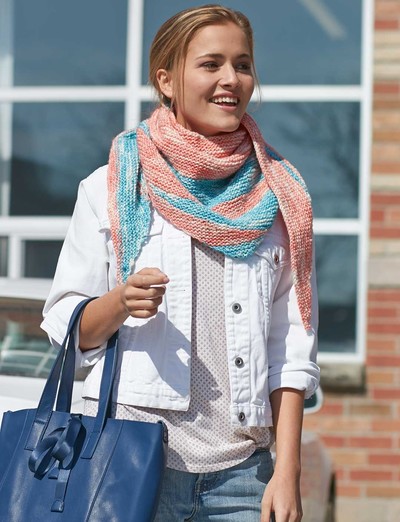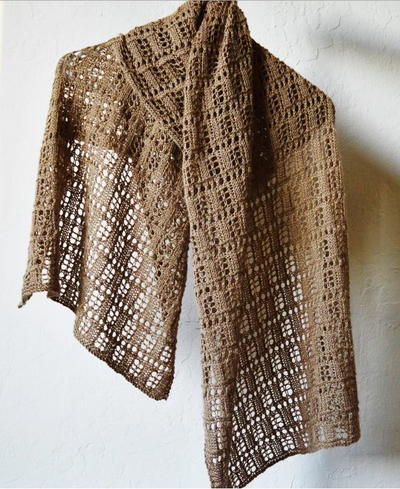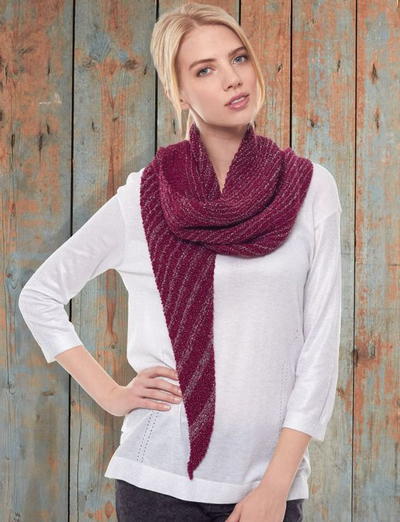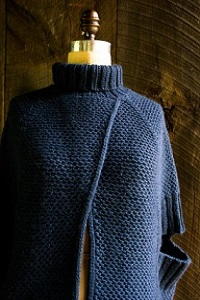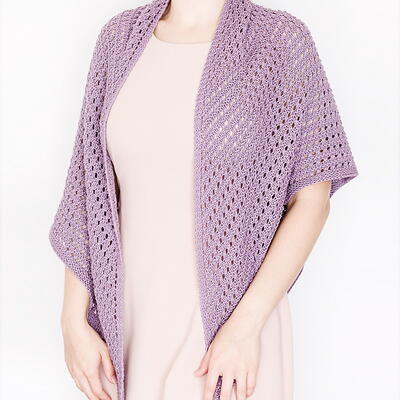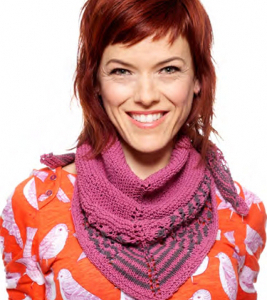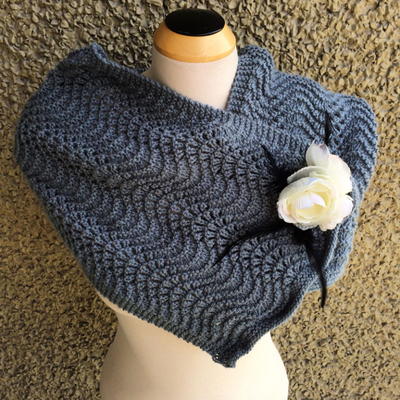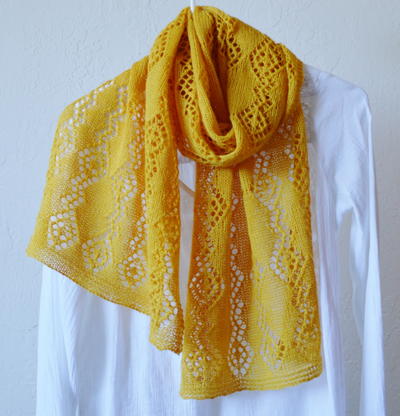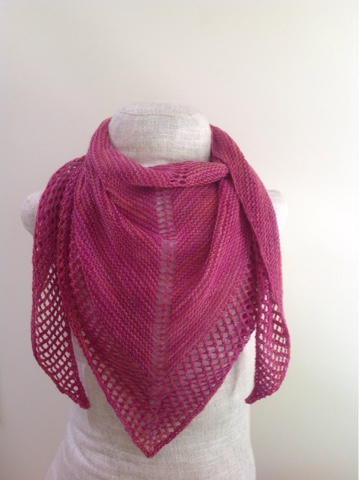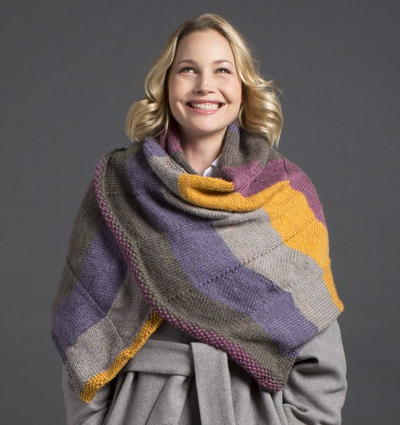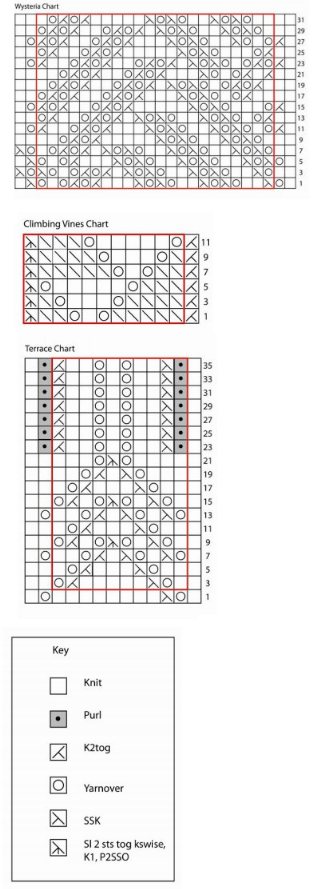Southern Sky Easy Knit Shawl
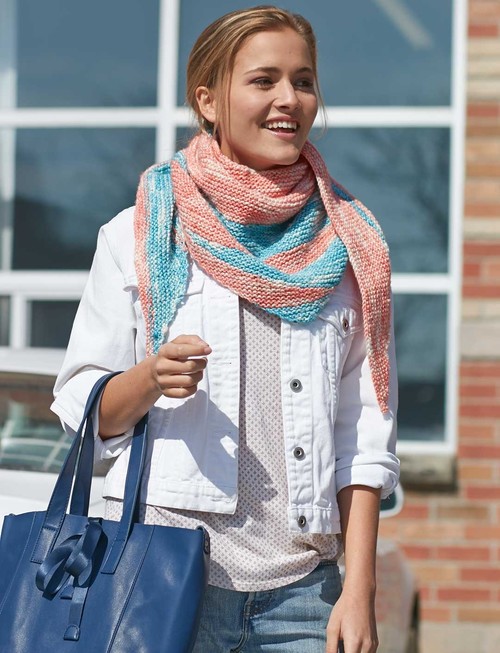
If you're looking for a versatile knit shawl with lovely colors, try knitting this Southern Sky Easy Knit Shawl. Bunched up on the neck, it looks like a cowl, but spread out, it has the length and shape of a shawl. The white-speckled blue playfully contrasts the pale orange for a unique, complementary coloring. This shawl is especially lovely against more neutral tones, which help the gorgeous colors stand out. Simple and delicate, this can be a summer shawl or a spring shawl, as it is light as air and wonderful for warmer months.
Knitting Needle Size8 or 5 mm, Circular Knitting Needles
Yarn Weight(4) Medium Weight/Worsted Weight and Aran (16-20 stitches to 4 inches)
Gauge1 stitches, 2 rows, 3 inches. stockinette stitch
Materials:
- Patons® Denim-y™ (3 oz/85 g; 144 yds/132 m)
- Contrast A: Teal Denim (96701) - 2 balls
- Contrast B: Tangerine Denim (96630) - 2 balls
- Size U.S. 8 (5 mm) knitting needles
- Size U.S. 8 (5 mm) circular knitting needle 29" [73.5 cm] long or size needed to obtain tension.
- Stitch marker.
Measurements: Approx 17" [43 cm] deep x 60" [152.5 cm] wide.
Abbreviations:
Approx = Approximately
K = Knit
Kfb = Increase 1 stitch by knitting into front and back of next stitch
PM = Place marker
Rem = Remaining
Rep = Repeat
RS = Right side
Sl1 = Slip next stitch knitwise
St(s) = Stitch(es)
WS = Wrong side
Gauge: 17 sts and 24 rows = 4" [10 cm] in stocking st.
Instructions
Note: Change to circular knitting needle when necessary to accommodate all sts.
With A, cast on 3 sts.
1st row: (WS). Kfb. K1. Kfb. 5 sts.
2nd row: Kfb. Knit to last st. Kfb.
Rep last row until there are 19 sts. Do not break A. Join B.
Next row: (RS). With B, as 2nd row. 21 sts.
Next row: Kfb. Knit to last 3 sts. Turn. Leave rem sts unworked.
Next row: Sl1. PM on last worked st. Knit to last st. Kfb.
Next row: Kfb. Knit to 3 sts before marked st. Turn. Leave rem sts on a spare needle.
Rep last 2 rows 10 times more.
Next row: Sl1. Knit to last st. Kfb.
Next row: Kfb. Knit across all sts to last st. Kfb. 47 sts. Break B.
Next row: With A, Kfb. Knit to last 5 sts.
Turn.
Leave rem sts on a spare needle.
Next row: Sl1. PM on last worked st. Knit to last st. Kfb.
Next row: Kfb. Knit to 4 sts before marked st.
Turn.
Leave rem sts on a spare needle.
Rep last 2 rows 10 times more.
Next row: Sl1. Knit to last st. Kfb. Do not break A. Join B. 71 sts.
Next row: (RS). With B, Kfb. Knit across all sts to last st. Kfb. 73 sts.
Next row: Kfb. Knit to last 7 sts.
Turn.
Leave rem sts on a spare needle.
Next row: Sl1. PM on last worked st. Knit to last st. Kfb.
Next row: Kfb. Knit to 6 sts before marked st.
Turn.
Leave rem sts on a spare needle.
Rep last 2 rows 10 times more.
Next row: Sl1. Knit to last st. Kfb.
Next row: Kfb. Knit across all sts to last st. Kfb. 99 sts. Break B.
Next row: With A, Kfb. Knit to last 5 sts.
Turn.
Leave rem sts on a spare needle.
Next row: Sl1. PM on last worked st. Knit to last st. Kfb.
Next row: Kfb. Knit to 4 sts before marked st.
Turn.
Leave rem sts on a spare needle.
Rep last 2 rows 20 times more.
Next row: Sl1. Knit to last st. Kfb. 143 sts. Do not break A. Join B.
Next row: (RS). With B, Kfb. Knit across all sts to last st. Kfb.
Next row: Kfb. Knit to last 7 sts.
Turn.
Leave rem sts on a spare needle.
Next row: Sl1. PM on last worked st. Knit to last st. Kfb.
Next row: Kfb. Knit to 6 sts before marked
st.
Turn.
Leave rem sts on a spare needle.
Rep last 2 rows 20 times more.
Next row: Sl1. Knit to last st. Kfb.
Next row: Kfb. Knit across all sts to last st. Kfb. 191 sts. Break B.
Next row: With A, Kfb. Knit to last 10 sts.
Turn.
Leave rem sts on a spare needle.
Next row: Sl1. PM on last worked st. Knit to last st. Kfb.
Next row: Kfb. Knit to 9 sts before marked st.
Turn.
Leave rem sts on a spare needle.
Rep last 2 rows 10 times more.
Next row: Sl1. Knit to last st. Kfb. 215 sts. Break A. Join B.
Next row: (RS). With B, Kfb. Knit across all sts to last st. Kfb. 217 sts.
Next row: Kfb. Knit to last 12 sts.
Turn.
Leave rem sts on a spare needle.
Next row: Sl1. PM on last worked st. Knit to last st. Kfb.
Next row: Kfb. Knit to 11 sts before marked st.
Turn.
Leave rem sts on a spare needle.
Rep last 2 rows 10 times more.
Next row: Sl1. Knit to last st. Kfb.
Next row: Kfb. Knit across all sts to last st. Kfb. 243 sts. Cast off.
Love this shawl, but need to brush up on the basics first? Take a look at our Knitting for Beginners Guide, complete with a bunch of free knitting patterns for beginners so you can get your feet wet!
Read NextLemon Lace Shawl Pattern
Your Recently Viewed Projects
Nanny
Aug 13, 2019
Apparently this is an older pattern with no tutorials or links. I was fortunate to locate the yarn on eBay. Now, however, Im having a most difficult time interpreting and following the instructions. Does turn mean wrap and turn as in knitting short rows? Is this the stitch that is then slipped (Sl 1)? What stitch is the last worked stitch on which the marker is placed? How are the remaining stitches transferred to the spare needle? Unless I use a circular needle throughout, I would have to move them in 2 steps - from left needle to a spare needle (on the right) and then back to the spare needle on the left. Thank you for your help.
Lisa
May 25, 2021
You are leaving the marker on the last worked stitch, which is the slipped stitch, turn means exactly that, you will turn and go back, no where in the pattern or the notes does it indicate its a wrap and turn, you could use wrap and turn, if you are experienced enough to use it. To transfer the stitches to a spare needle, you will simply slip them without working them to the spare, I use a circular to knit the whole thing, I leave my transferred stitches on the circular, then use straights or another set of circulars to work the shaping, then when the held stitches are incorporated back into the pattern I'm down to one needle again.
Tricia108
Aug 24, 2017
It is not the best written pattern. I had to read the comments and then read the pattern a few times but now I think I have it. It will make for a nice scarf/cowl/shawl. It can be worn several ways and it won't be one design you see all over the place. I am going to try it. Thanks
The Designing Peng uin
Jun 15, 2016
what a great way to wear a shawl - and what a lovely pattern these colours are beautiful together, but think of the dozens of other combinations possible.
rsdb
Mar 21, 2016
Nice pastel colored yarn used for a spring or summer shawl. I like the way it is described - a shawl and cowl depending on how it is worn! But from the comments it seems that the pattern is not as easy to follow. Has anyone made this shawl cowl using the pattern successfully?
cmbglass 1557439
Mar 08, 2016
Read through the pattern update. The direction where you leave 5 stitches unworked has no number of repeats. The video says 10 times? What is the correct direction?
taulbeebrenda 8454 329
Aug 27, 2015
This is the most difficult pattern I have ever tried to knit! It makes no sense at all. There is never an explanation for the stitches that are "left not knitted on a spare needle". Who ever leaves stitches unknitted on a needle?
Lisa
Nov 01, 2015
Its called short row shaping and its not an uncommon knitting technique. The stitches are not left completely unworked they are only left unworked temporarily, they are incorporated back into the piece a few rows later when it says worked acroos all stitches, that means all the stitches are back on the needle, you can see this in the pattern by looking at how many stitches you should have after working everything back in. It allows you to shape in certain colours and places on a piece without casting on or off in the middle. Hope this helps, happy knitting.
Iknit4fun2 5149628
Jun 09, 2015
Where can I find this tutorial? I looked at Vickiehowell.cons site but could not find it anywhere there?
Cathy08
May 16, 2015
Vickie Howell has a tutorial for this shawl with step by step instructions.
rgwarren2 6426787
Apr 29, 2015
I too am having the same problems as the person who ha been knitting for 55 years. What does pm on last worked st mean. No spare needle is mentioned in materials for project. What do you do with sts on spare needle.
Iknit4fun2 5149628
Apr 26, 2015
I've been knitting for 55 years. I just got this easy pattern. Who are you kidding? I have no idea how to read this pattern. I've never put a stitch marker on a stitch. (A marker is usually placed on the needle). What kind of spare needle am I supposed to use to hold the remaining stitches? You say to "sl1. PM on last worked st." What is the last worked stitch? Is it the sl1. This is a terrible pattern. It needs to be rewritten. You can send me the corrections since I've joined All Free Knitting to be able to leave this comment.
Lisa
Apr 28, 2016
The pattern is actually fine the way it is written, I think the people having issues with it are just not understanding short row shaping, for that reason I would not have called it easy, but for the people who do know short row shaping it is in fact an easy pattern. It's not uncommon to place a marker on a stitch in knitting, I've been knitting as long as you and have seen this many times. I'm certain if you look up a short row knitting video or tutorial, you'll have no problem completing this pattern. Happy knitting.
Lisa
Apr 03, 2015
I used to have that problem also, then a friend showed me that I should wrap and turn on short rows(even when the pattern does not call for it) I've used WT ever since and it has never been an issue again. Happy knitting.
ldeernest 6782024
Mar 03, 2015
this pattern is downloadable at yarnspirations.com/patons
reenakaur 2562505
Mar 06, 2015
I love this beautiful pattern and thank you for sharing.I do have a probelm with the short row where I get a hole every time! Have you got ranother suggestion or tutorial for the shawl.Thank you.
Report Inappropriate Comment
Are you sure you would like to report this comment? It will be flagged for our moderators to take action.
Thank you for taking the time to improve the content on our site.

